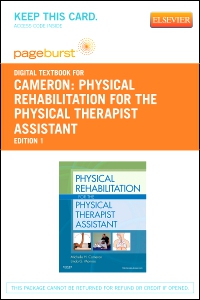
Physical Rehabilitation for the Physical Therapist Assistant - Elsevier eBook on VitalSource (Retail Access Card), 1st Edition
Elsevier eBook on VitalSource - Access Card

Prepare your students for practice with the rehabilitation textbook written specifically for physical therapist assistants! Physical Rehabilitation for the Physical Therapist Assistant is a clear, easy-to-read, evidence-based guide to the PTA's role in managing patients. Following the format of the American Physical Therapy Association (APTA) Guide to Physical Therapist Practice, this text covers core concepts related to physical rehabilitation and emphasizes the PTA's unique role in physical assessment and intervention. This text will be a valuable resource for your students both in the classroom and in professional practice.
-
- Comprehensive, evidence-based coverage of rehabilitation includes sections on pathology; examination; evaluation, diagnosis, and prognosis; clinical signs, and intervention -- emphasizing the PTA's role in intervention.
- Unique! A consistent, organized approach covers physical therapy intervention by disorder, with full discussions of each condition found in a single chapter.
- Format follows the Guide to Physical Therapist Practice, 2nd Edition with a section of the book dedicated to each of the four categories of the APTA Preferred Practice Patterns -- musculoskeletal, neuromuscular, cardiopulmonary, and integumentary -- with a fifth section to address interventions which overlap many practice patterns.
- Learning objectives in each chapter set goals and help students focus their study.
- Clinical Pearls highlight key information.
- Unique! Full-color illustrations clearly demonstrate pathologies and interventions.
- Case studies with questions challenge the student to apply evidence-based concepts directly to patient care.
- Glossaries at the end of each chapter provide definitions of key terms to build students' clinical vocabularies.
- Unique! Student resources on the companion Evolve website include vocabulary-building exercises, boards-style practice test questions, examples of commonly used forms, and references from the book linked to Medline abstracts.
- Unique! Instructor resources on Evolve include PowerPoint® lecture slides, the complete image collection from the text, test bank questions, additional case studies, and complete reference citations linked to Medline.
-
1. Introduction
2. Evidence-based Practice
Part One: Musculoskeletal System
3. Skeletal Demineralization
4. Posture
5. Muscle Weakness
6. Connective Tissue Dysfunction
7. Localized Inflammation
8. Spinal Disorders
9. Fractures
10. Joint Arthroplasty
11. Soft Tissue Surgery
12. Amputation and Prostheses
Part Two: Neuromuscular System
13. Balance and Fall Risk
14. Impaired Neuromotor Development
15. Pediatric Nonprogressive Central Nervous System Disorders
16. Adult Nonprogressive Central Nervous System Disorders
17. Progressive Central Nervous System Disorders
18. Peripheral Nerve Injuries
19. Polyneuropathies
20. Nonprogressive Spinal Cord Disorders
21. Disorders of Consciousness: Coma, Vegetative State and Minimally Conscious State
Part Three: Cardiopulmonary System
22. Vital Signs
23. Deconditioning
24. Airway Clearance Dysfunction
25. Congestive Heart Failure
26. Respiratory Failure
27. Lymphatic System Disorders
Part Four: Integumentary System
28. Tissue Healing and Pressure Ulcers
29. Vascular Ulcers
30. Neuropathic Ulcers
31. Burns
Part Five: Interventions Common to Many Conditions Requiring Rehabilitation
32. Gait Assessment and Training
33. Assistive Devices for Mobility: Canes, Crutches, Walkers, and Wheelchairs
34. Orthotics


 as described in our
as described in our 